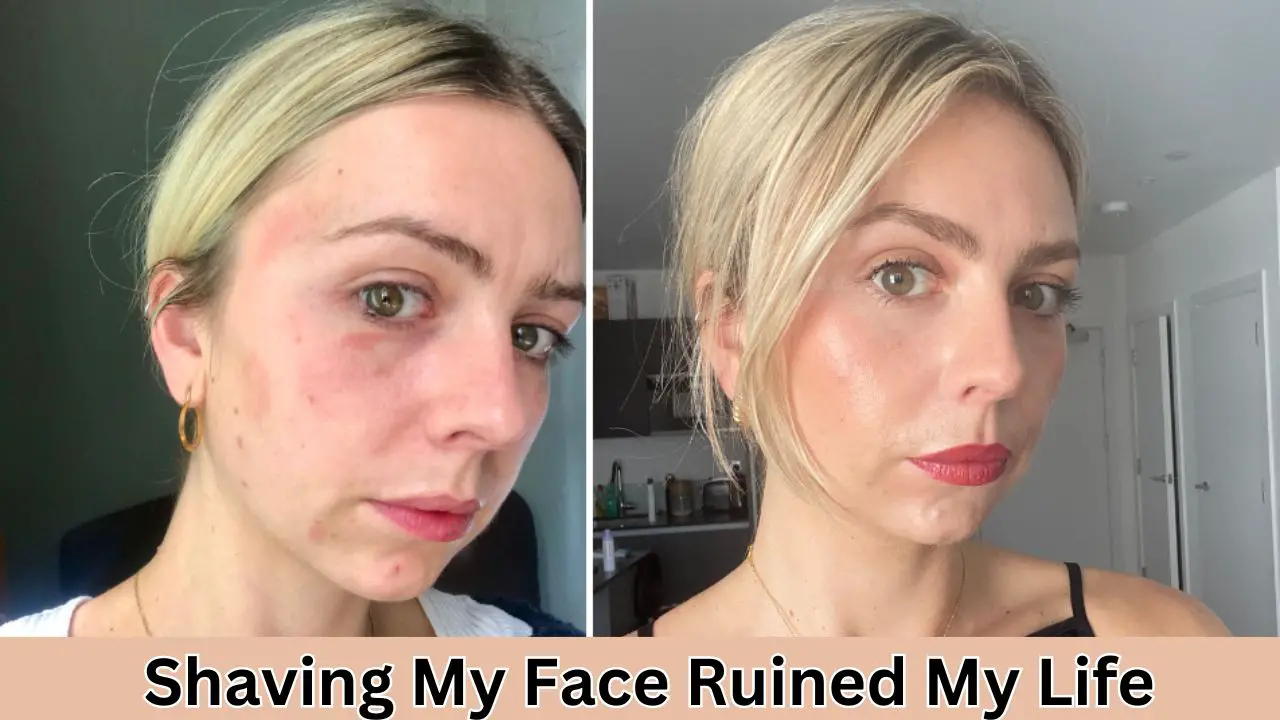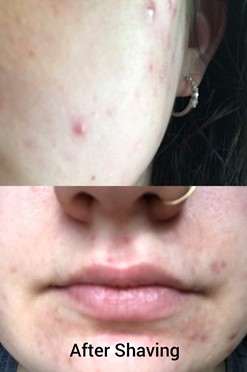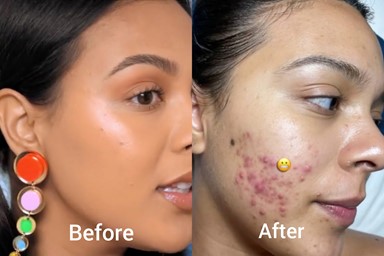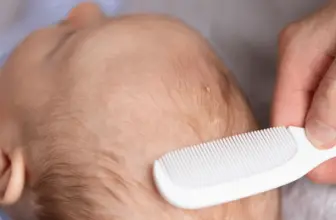Shaving My Face Ruined My Life – The Unexpected Downfall

In recent years, the practice of facial shaving among women has gained popularity as a means to achieve smoother and brighter skin. It has garnered admiration and caution from women who have entered this practice.
So, why are some women saying that shaving my face ruined my life?
Elicia’s experience with facial shaving led to smoother skin but makeup issues and rash-like bumps. Natalie’s dermaplaning horror resulted in breakouts, pain, and inflammation. Keagan’s regrettable shave with men’s razors left her with cuts and red patches. These cautionary tales highlight the importance of using proper tools and seeking professional advice.
In this article, we will glean insights from real-life experiences while delving into women’s facial shaving, unveiling its advantages and drawbacks.
Elicia’s Experience with Facial Shaving and Skin Reactions
Elicia decided to try facial shaving for smoother skin and to address some dry, flaky patches. She used a Harry’s razor with a shaving cream lotion combo.
Initially, she was cautious due to her cystic acne but proceeded carefully. She was surprised by the amount of hair and dead skin that came off.
After shaving, she noticed smoother and brighter skin but also experienced makeup not staying as well and uneven fading.

Source: Insider
Later, she developed tiny rash-like bumps around her mouth and chin, similar to another blogger’s experience. She applied hydrocortisone and planned to consult a dermatologist.
Natalie’s Face-Shaving Beauty Hack Goes Wrong: A Warning Tale
Natalie, a content creator known for her hair and beauty tips, recently shared a cautionary tale on her platform. She decided to try dermaplaning, a face-shaving hack meant to remove hair, dirt, and dead skin cells.
However, her experience took a disastrous turn. In a detailed video, Natalie expressed her horror at the results, describing how dermaplaning initially left her skin looking great but quickly became a nightmare.

Source: Natalies Outlet
She explained her breakout, with her skin becoming bumpy, painful, and inflamed.
After numerous skin treatments, Natalie restored her skin to its natural, clear state.
Her message to her followers was clear: Leave beauty hacks to the professionals and avoid trying everything you see online.
Natalie’s video garnered 6.3 million views, and opinions in the comments section were divided. Some viewers claimed the hack worked perfectly, while others shared similar negative experiences.
Keagan’s Regrettable Shave
In her recent YouTube video, Keagan candidly shared her facial hair removal journey, which turned into a cautionary tale due to her mistake.
Eager to achieve a smooth complexion, Keagan opted for razors typically marketed towards men, under the impression they would provide a gentle shave.
Unfortunately, her assumption couldn’t have been more wrong.
The result? A face marred with cuts, angry red patches, and undeniable discomfort. Keagan knew she had to share her experience to prevent others from making the same mistake.
In her video, she earnestly recommended using razors explicitly designed for women. She explained this could significantly reduce the risks of nicks and irritation.
But Keagan didn’t stop there; she stressed the importance of a simple remedy – ice cubes. Applying ice cubes to her affected areas helped to alleviate the redness and soothe the razor-induced cuts.
Pros Of Shaving Face In Women
Shaving the face in women, also known as dermaplaning, has gained popularity for several reasons:
- Exfoliation: Shaving removes dead skin cells, leaving your skin feeling smoother and brighter.
- Makeup Application: A smooth canvas helps makeup go on more evenly, creating a flawless finish.
- Hair Removal: It effectively removes fine facial hair, often called “peach fuzz,” which can make makeup sit better and give the skin a smoother texture.
- Product Absorption: Skincare products can penetrate the skin more effectively after shaving, enhancing their effectiveness.
- Minimal Discomfort: Shaving is painless and doesn’t involve chemicals or harsh ingredients.
- Cost-Effective: It’s affordable compared to other facial hair removal methods like waxing or laser treatments.
- Safe: When done correctly with the right tools, shaving is safe and doesn’t lead to thicker or coarser hair growth.
Cons of Shaving Face in Women
While shaving the face in women can have its benefits, it also comes with some potential drawbacks:
- Skin Damage and Irritation: Nicks, cuts, and razor burns are inherent shaving risks. These can be painful and may lead to infections if not cared for properly. Individuals with naturally dry or sensitive skin are at greater risk of experiencing irritation and may find that shaving exacerbates these issues, potentially causing dryness, flaking, or itching post-shave.
- Temporary Results: Hair grows back relatively quickly after shaving, so the smoothness achieved is short-lived compared to other hair removal methods.
- Ingrown Hairs: There’s a chance of developing ingrown hairs, particularly if the hair is cut too close to the skin’s surface.
- Stubble: As hair regrows, it may feel coarser and appear as stubble, which can bother some individuals.
- Time-Consuming: Shaving can be a regular maintenance task, as the hair regrowth requires frequent touch-ups.
- Potential for Unevenness: Achieving an entirely even shave can be challenging, which may result in an uneven skin texture.
- Unsuitable for Thick Hair: Shaving is less effective for thicker or coarse facial hair types, as it may only remove the hair partially.
- Post-Shave Breakouts and Long-Term Compatibility: As with any form of exfoliation, some purging or breakouts can occur in the days following a shave. These should subside fairly quickly. If breakouts persist or worsen over time, it may suggest that shaving isn’t the best fit for your skin.
Will Shaving Make Facial Hair Thicker?
Contrary to a common myth, shaving facial hair does not make it grow thicker or change its color. Shaving only blunts the hair’s edges, making it feel stubbly until it ultimately grows out.
When Should Women Avoid Shaving Their Faces?
- Skin Sensitivity: If you have sensitive skin that is prone to irritation, you may experience redness, bumps, or ingrown hairs as a result of shaving.
- Acne or Breakouts: Shaving over active acne or breakouts can exacerbate the condition and facilitate bacterial spread, potentially resulting in more blemishes.
- Medication Side Effects: Certain medications can make the skin more sensitive or prone to cuts, so avoiding shaving in such cases is advisable.
- Allergic Reactions: Some individuals may be allergic to shaving products, causing skin rashes or itching. Always patch-test new products.
- Skin Conditions: Individuals with skin conditions like eczema, psoriasis, or rosacea may experience worsened symptoms or discomfort when shaving.
- Recent Sunburn: Shaving over sunburned skin can be painful and may delay the healing process.
- History of Keloids: Shaving can increase the risk of keloid formation on the shaved area if you’re prone to developing keloid scars.
- Hormonal Changes: Hormonal fluctuations during pregnancy or menopause can affect skin sensitivity, making shaving less comfortable.
- Surgical Procedures: After certain facial surgeries or cosmetic treatments, following post-operative care instructions is essential, which may exclude shaving.
Always seek individualized guidance on facial hair removal from a dermatologist or skin care specialist, especially if you have specific issues or medical conditions.
Best Practices For Shaving Your Face As A Woman
If you choose to shave your face, follow these steps for a safe and effective experience:
- Cleanse and Dry: Start with clean, dry skin, free from makeup or products.
- Apply Shaving Gel: Before you start shaving, apply a thin layer of shaving gel or cream to the area you want to shave. This helps to create a barrier between your skin and the razor, reducing friction and preventing irritation.
- Use the Right Razor: Opt for a straight-edge, single-blade razor designed for women’s facial shaving or dermaplaning.
- Gentle Technique: Hold the skin taut with one hand and the razor at a 45-degree angle. Use short, light strokes in the direction of hair growth with minimal pressure.
- Rinse After Each Stroke: Rinse the razor to remove hair and gel buildup after each stroke. This ensures a clean and effective shave.
- Moisturize After Shaving: Rinse your face with cool water and pat it dry gently with a clean towel. Then, apply a soothing, alcohol-free, cold aloe vera gel to your skin. This helps to hydrate and calm your skin after shaving.
- Ice cubes: Use an ice cube wrapped in a clean cloth to gently glide over your freshly shaved skin. This can help reduce redness and close the pores.
- Avoid Harsh Skin Care: Avoid applying harsh skin care products or makeup immediately after shaving to prevent further irritation.
Alternatives To Facial Shaving for Women
- Waxing: Offers longer-lasting results but can be painful and may cause ingrown hairs.
- Laser Hair Removal: Provides semi-permanent hair reduction and is best done by professionals. Effective for women with darker hair and lighter skin.
- Depilatory Creams: An option for temporary hair removal, but some may have skin reactions.
- Threading: Effective for shaping eyebrows and removing facial hair. It requires a skilled practitioner and may cause discomfort.
- Topical Prescriptions: Vaniqa is a prescription cream that can reduce facial hair growth but is not permanent.
Frequently Asked Questions (FAQs)
What Happens If I Stop Shaving My Face?
If you stop shaving your face, you might notice a buildup of dead skin cells on the surface. Because of this layer, moisturizers may have a harder time working well. However, each person may experience the influence differently on their skin’s overall health and appearance.
What Is The Right Age To Shave Facial Hair For A Girl?
The right age to start shaving facial hair for a girl varies from person to person and largely depends on individual preferences and comfort. It’s a personal decision that should be made based on their readiness and the guidance of trusted adults or professionals if needed.
Can I Use Coconut Oil To Shave My Face?
Yes, you can use coconut oil to shave your face. It can be used for shaving various body parts, but it may be better for individuals with especially oily facial skin.
The Final Verdict
In the world of women’s facial shaving, the experiences shared as shaving my face ruined my life offer valuable lessons. While dermaplaning can bring benefits like exfoliation and smoother skin, it’s not without risks – from irritation to stubble.
Keagan’s advice on using the right tools and the soothing remedy of ice cubes highlights the importance of care.
Facial shaving can enhance your beauty routine, but understanding its nuances is critical to avoiding potential pitfalls.





